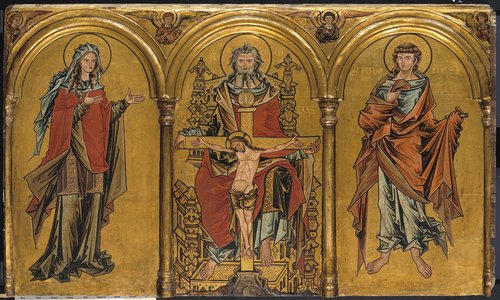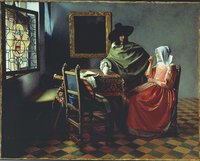Vom originalen Rahmen der Tafel haben sich die Bögen und Halbsäulen erhalten, die die Bildfläche in drei gleich große Felder teilen. Das mittlere Feld zeigt die Darstellung der Heiligen Dreifaltigkeit mit Gottvater auf dem Thron, Christus am Kreuz und dem Heiligen Geist in Gestalt der Taube. Gottvater wird durch den ersten und letzten Buchstaben des griechischen Alphabets, Alpha und Omega, neben seinem Haupt als Anfang und Ende bezeichnet. Er weist dem Betrachter den toten Sohn am Kreuz vor, das aus einem Felsen emporwächst. Dadurch findet die Doppelnatur Christi, der Mensch und Gott zugleich ist, anschauliche Gestaltung. Links und rechts stehen Maria und Johannes, die als Fürbitter an den Thron Gottes herangetreten sind und Gnade für die sündige Menschheit erbitten. Die Darstellung der Trinität veranschaulicht das Opfer des Gottessohnes, in dem sich die Gnade Gottvaters offenbart. Sie verweist gleichzeitig auf das sich stets erneuernde Opfer in der Messe am Altar. Die Gestaltung ist von einer geometrisch-kristallinen Stilisierung des Faltenwurfs geprägt. Alle Formen sind in kantige und scharfe Gebilde aufgelöst. Die abstrahierende Übersteigerung der Stilelemente bezeichnet die Spätphase des »Zackenstils«, der sich hier in seiner reifsten Ausbildung darstellt. |--Hier Übersetzung--::::::::::::::__ The arches and pilasters have survived from the original frame of the altarpiece and divide the picture into three fields of equal size. The central field shows the Holy Trinity with God the Father on the throne, Christ on the cross and the Holy Spirit in the form of a dove. God the father is identified as the beginning and the end by the alpha and omega which are to be seen by his head. He is showing the viewer his dead son on the cross, which seems to grow out of a rock. This is a vivid representation of the dual nature of Christ, who is both God and man. This representation of the Trinity symbolises the sacrifice of the Son of God, while revealing the grace of God the Father. It also refers to the repetition of the same sacrifice witnessed in the mass. On the left and right are Mary and John, who have come to God’s throne to intercede for grace for sinful mankind. The characteristic feature of the design is the geometrical and crystalline stylisation in the arrangement of the drapery. The exaggeration and abstraction of the stylistic elements are typical of the late phase of the so-called “Zackenstil” (jagged, serrated style), seen here at its most mature.
en

